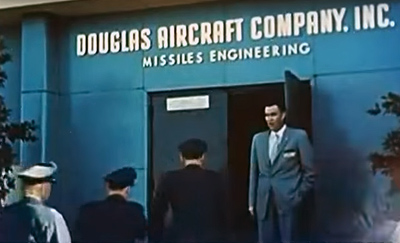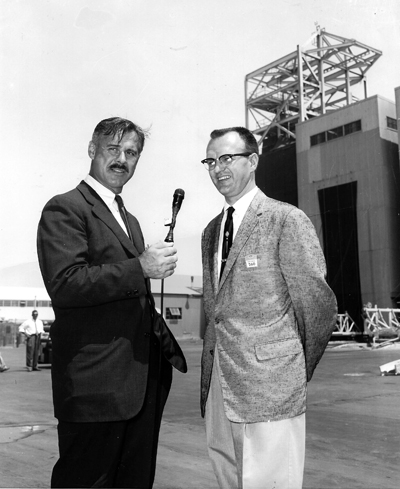Maxwell Hunter was recruited by Douglas Aircraft, in Santa Monica, California, to work on the design of experimental versions of two of the company's B-42 and B-43 bombers, and then transferred to the team starting missile development.
|
The Douglas XB-42 Mixmaster was an experimental bomber aircraft, designed for a high top speed. Douglas Aircraft's Missile Headquarters in Santa Monica, California. Maxwell Hunter being interviewed at Douglas Aircraft Co. Max Hunter was with the Douglas Aircraft Company for 18 years from 1944 to 1961. He was recruited to work on the design of experimental versions of two of the company's B-42 and B-43 bombers, His spent two-and-half years dealing with the performance of transport aircraft as Douglas continued to develop new aircraft, including the successful four-engine Douglas DC-6 (1946). For some time, Hunter was in charge of all calculations on the performance and economics of the DC-6 and DC-7 airliners. He moved to the newly-formed missile engineering department and spent eight years running the Missile Aerodynamics Department during a period in which Douglas built a large number of production weapons. He was in charge of missile aerodynamics for the Nike surface-to-air missiles Ajax and Hercules, the Sparrow air-to-air missile for the Navy, the Honest John artillery rocket for the Army, and the Genie air-launched nuclear interceptor for the Air Force. "The Chief Design Engineer in those days was supposed to concentrate all his time worrying about whether the designs were right. There was also an Administrative Engineer of equal rank to be sure the Design Engineer didn't have to waste his time on management details. Can you believe their once were such organizations?" He was responsible for the design Nike-Zeus and was the principal designer of Thor, the first operational ballistic missile deployed by the U.S. Air Force (USAF). It was deployed in the United Kingdom between 1959 and September 1963 as an intermediate-range ballistic missile (IRBM) with thermonuclear warheads. Subsequently, he was named Chief Engineer of Space Systems responsible for the engineering of all Douglas space efforts. A large family of space launch vehicles—the Thor and its civilian counterpart Delta—were derived from the Thor design. The Delta II and Delta IV are still in active service in 2017 and, with the retirement of Atlas and Titan in the mid-2000s, are the last surviving "heritage" launch vehicles in the US fleet derived from a Cold War-era missile system NASA also awarded Douglas one of few outside contracts to build a major part of the Saturn rocket, the S-IV stage (third stage) under the direction of Wernher von Braun. Max and Von Braun became acquainted during the fierce development competition between Douglas’ Thor for the Air Force and Marshal Space Center’s (under direction of von Braun) Jupiter for the Army. They emerged friends and colleagues during the development of the S-IV stage for which Max had responsible as Chief Engineer of Space Systems. While serving as head of the Douglas internal Space Committee, Max conceived the idea of a nuclear- powered rocket known as RITA, for Reusable Interplanetary Transport Approach. It promised "economy of operation, convenience in terms of flight schedule, ease of maintenance, and versatility of utilization." It would be a reusable, single-stage-to-orbit launcher capable of carrying payloads into orbit, to the Moon, or to other planets. "The real reason for building nuclear space transport vehicles," the RITA report argued, "is their ability to achieve low cost space transportation." Max left Douglas to join President Kennedy’s National Aeronautical and Space Council in early1962.
Related Publications: “Impulsive Midcourse Correction of a Lunar Shot” “Manned Nuclear Space Systems” “The Advantages of High Thrust Space Vehicles” “The Potential of Nuclear Space Transport Systems” “Direct Operating Cost Analysis of a Class of Nuclear Spaceships” “The Cost of Lunar Travel” “RITA – The Reusable Interplanetary Transport Approach” “Early Interplanetary Exploration with Nuclear Rockets” “Advanced Manned Space Systems” “Capabilities of Advanced Vehicles for Astronomical Research” |





